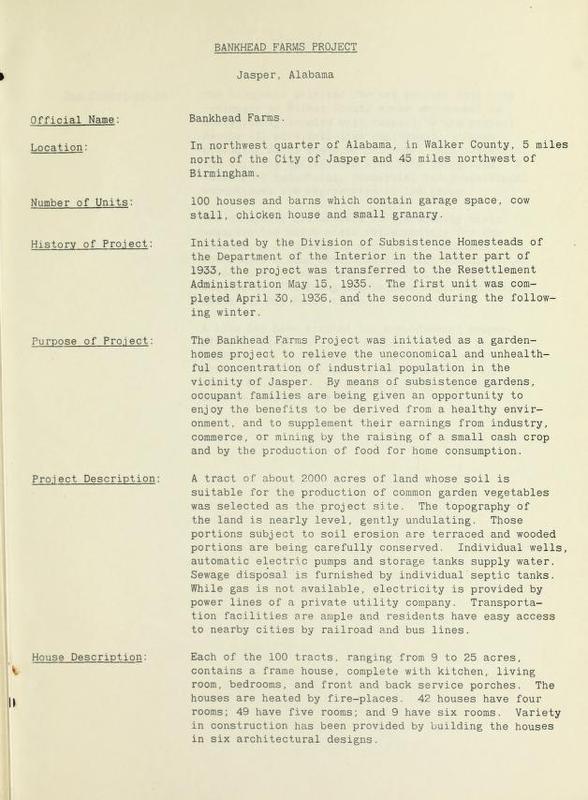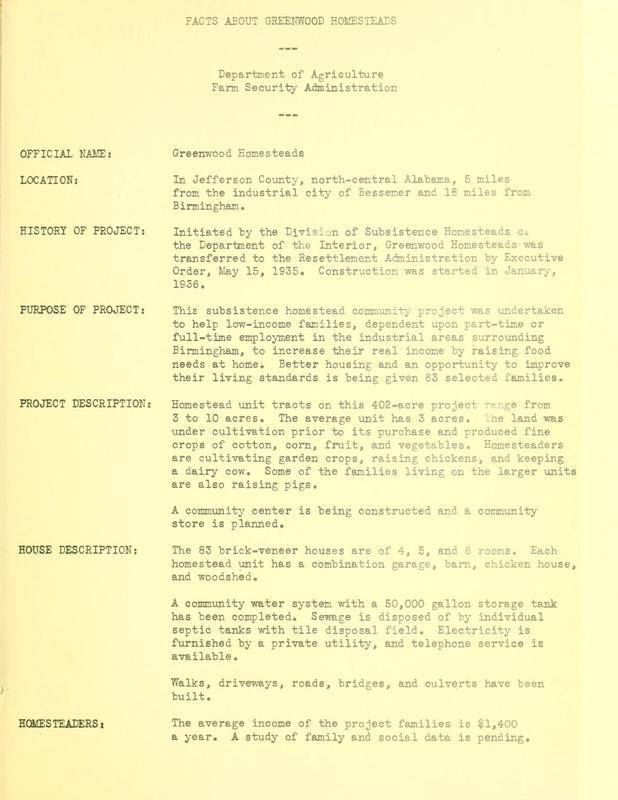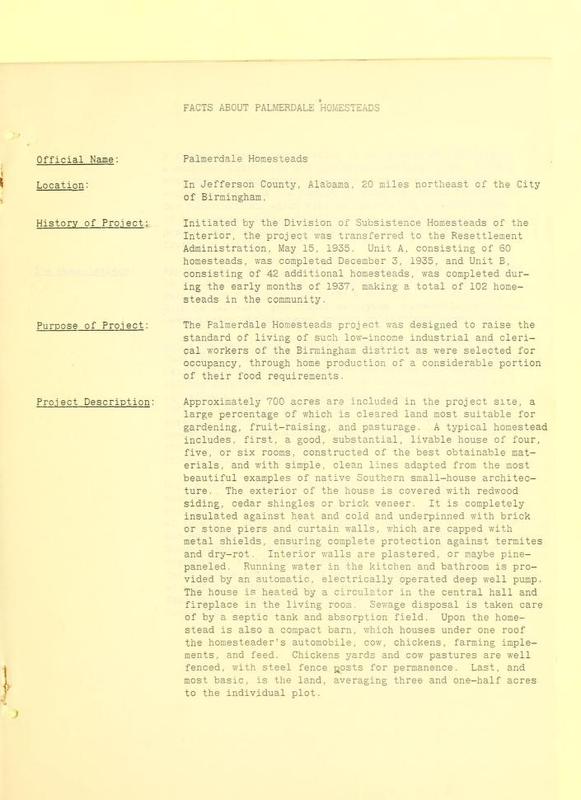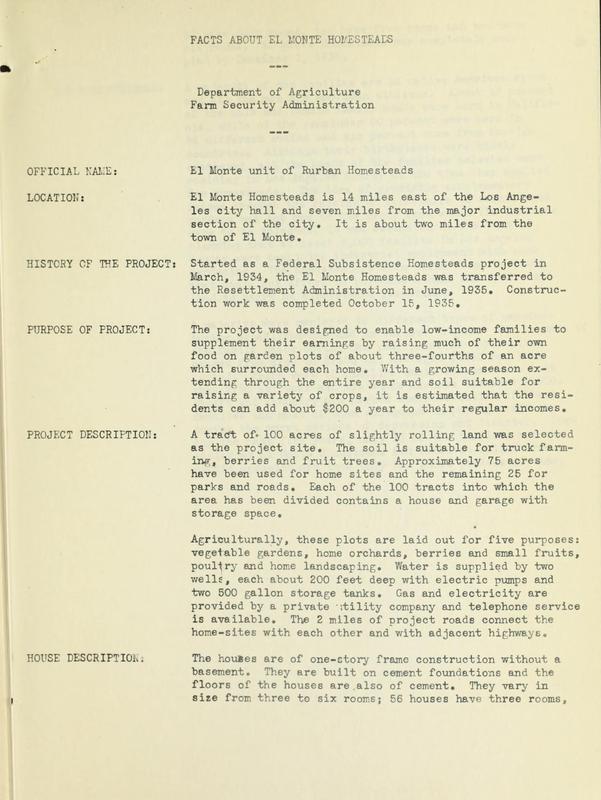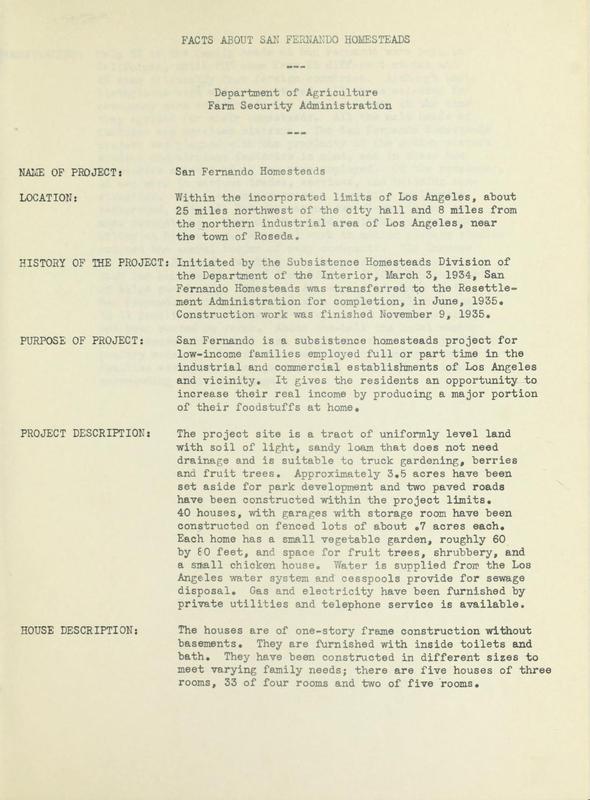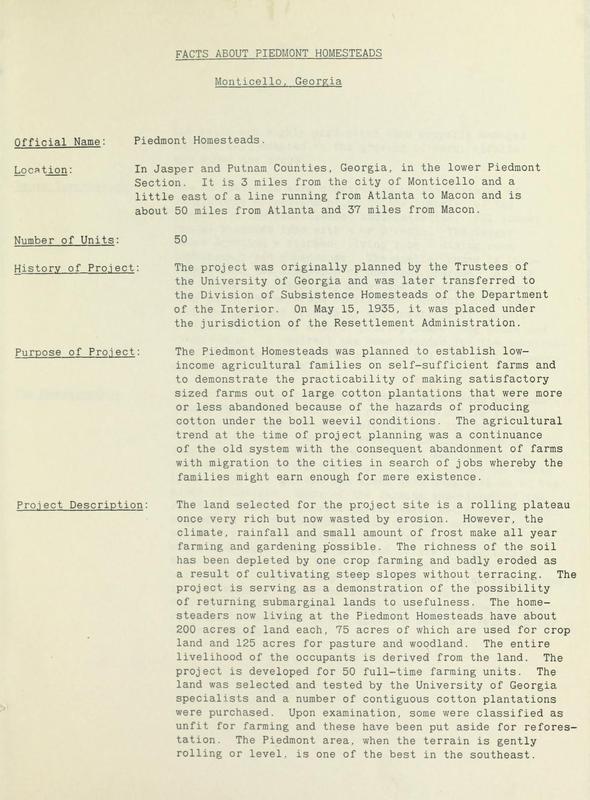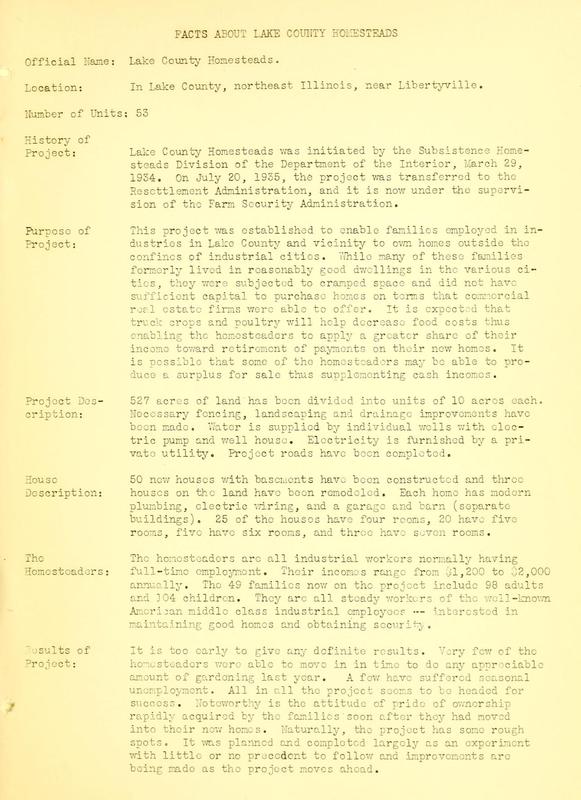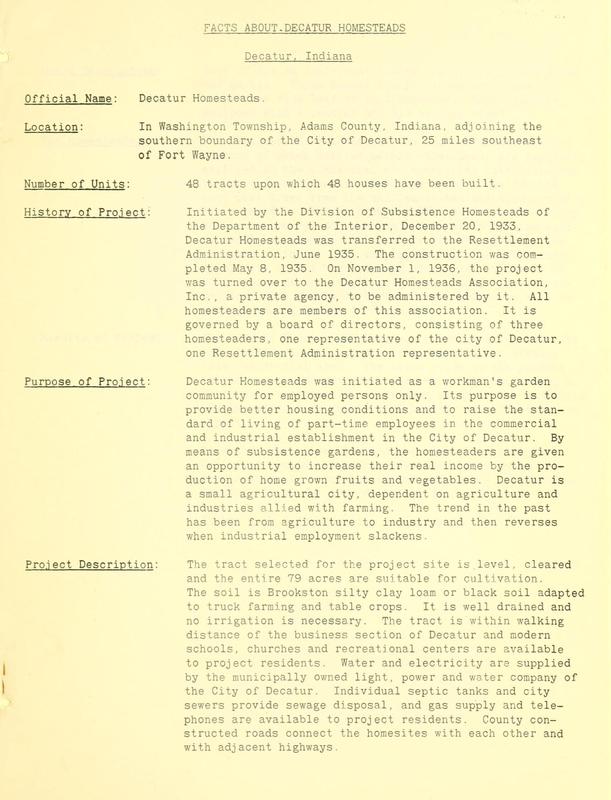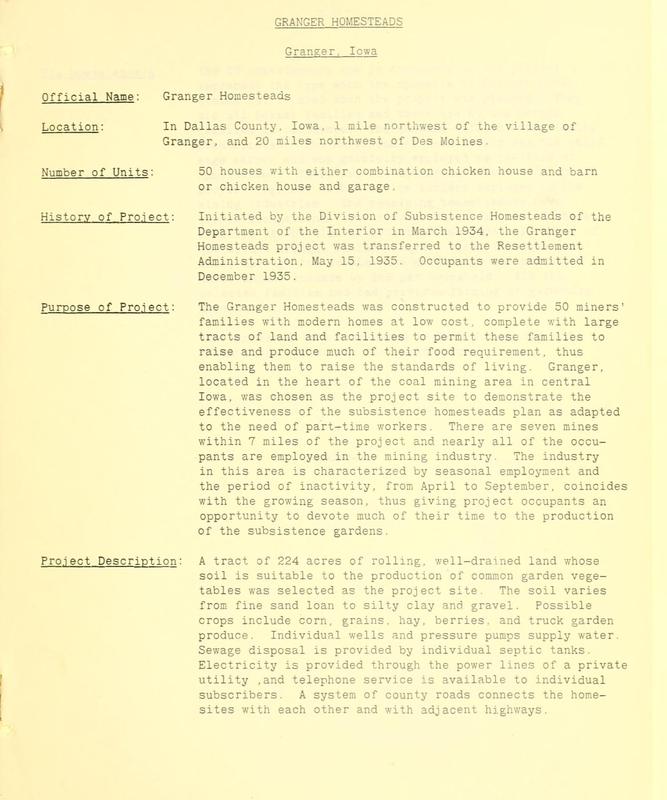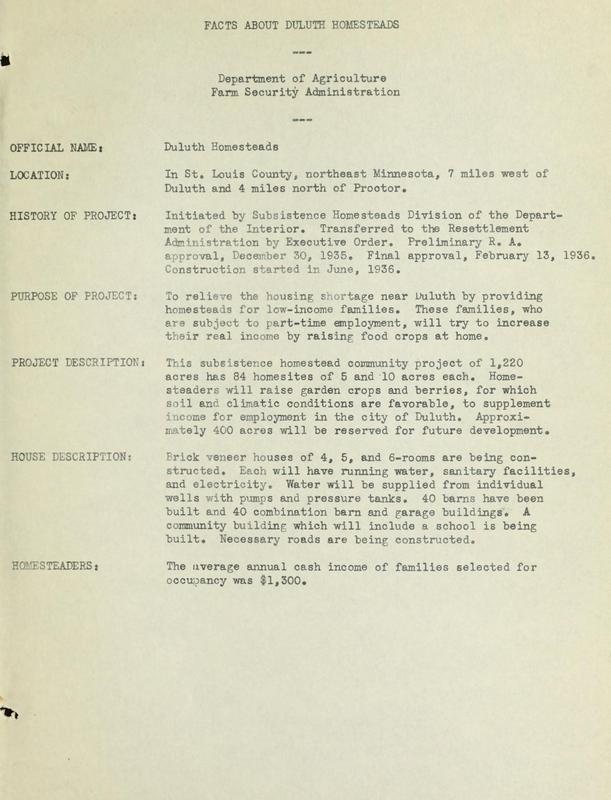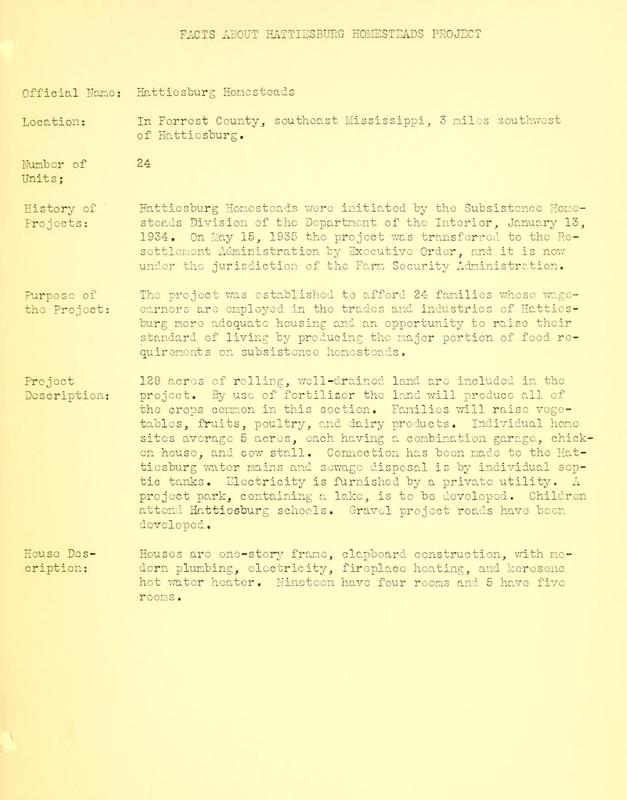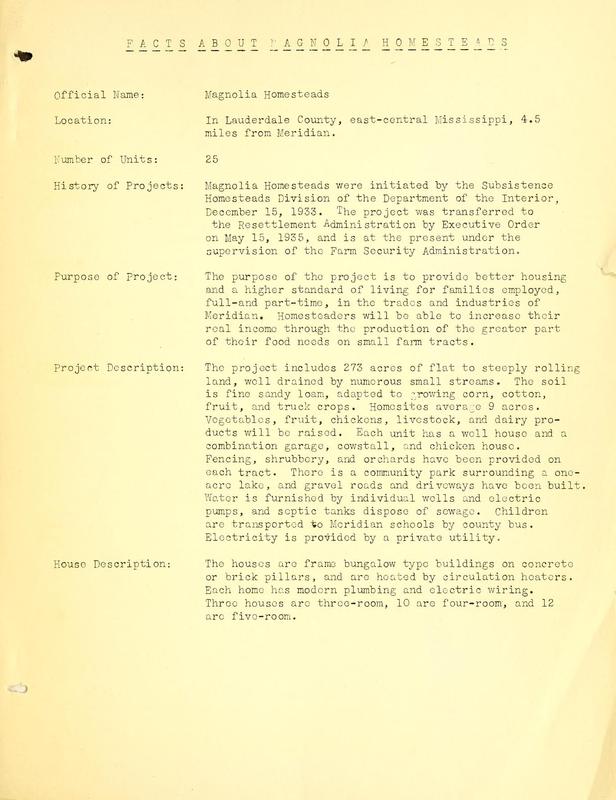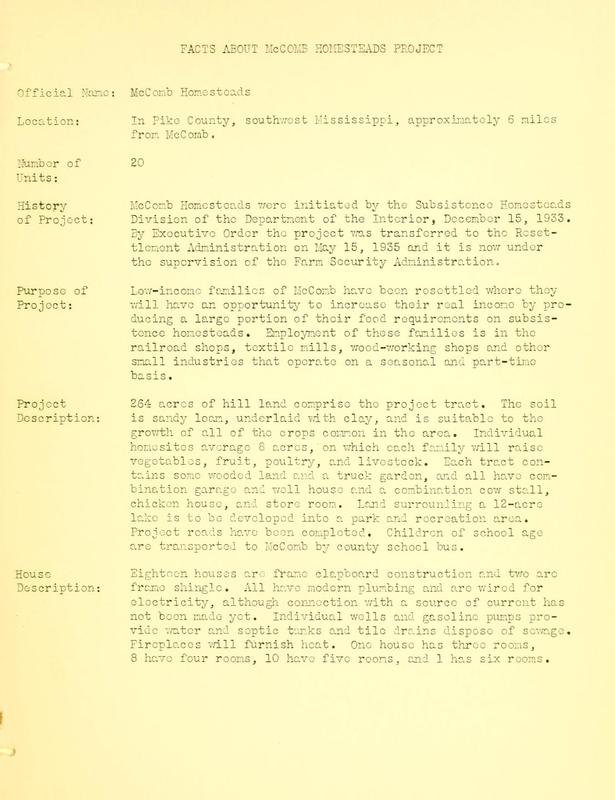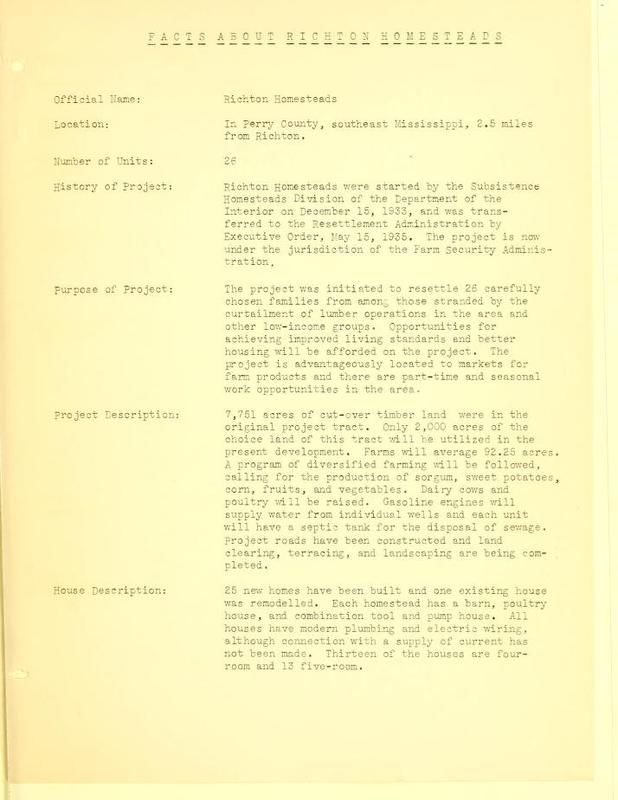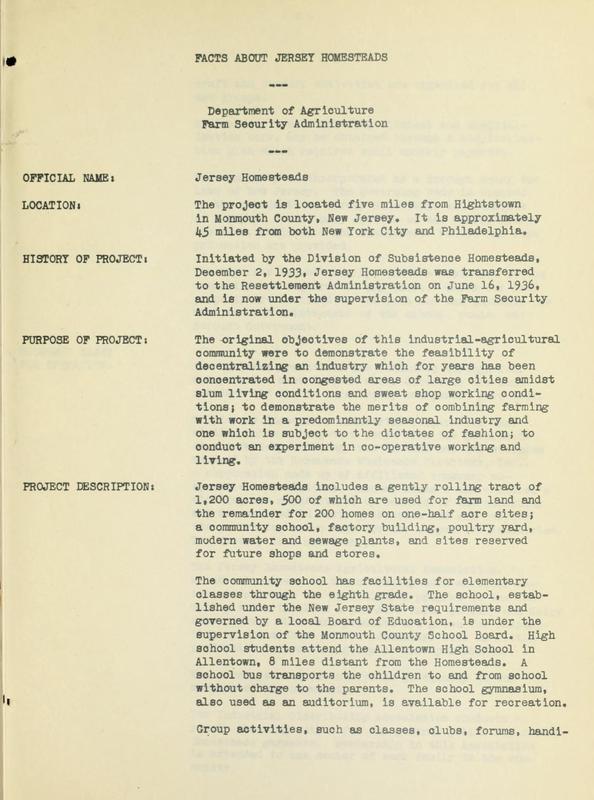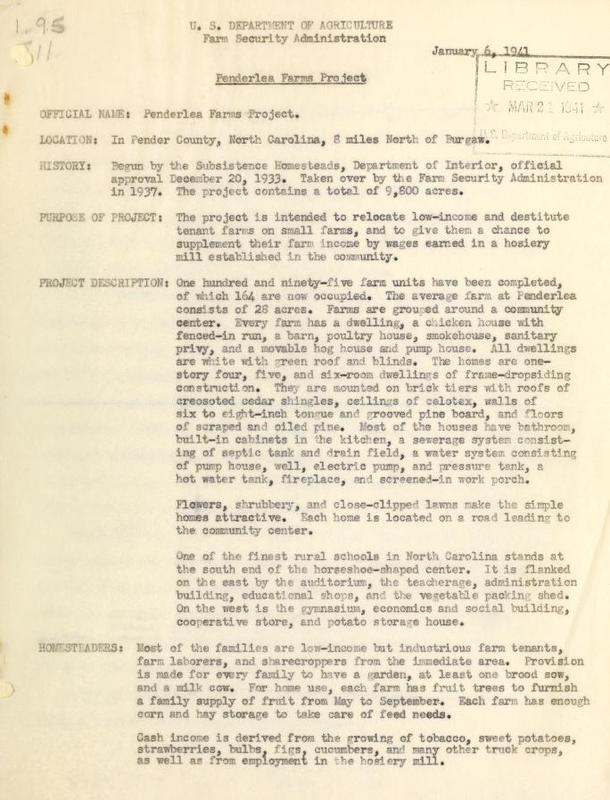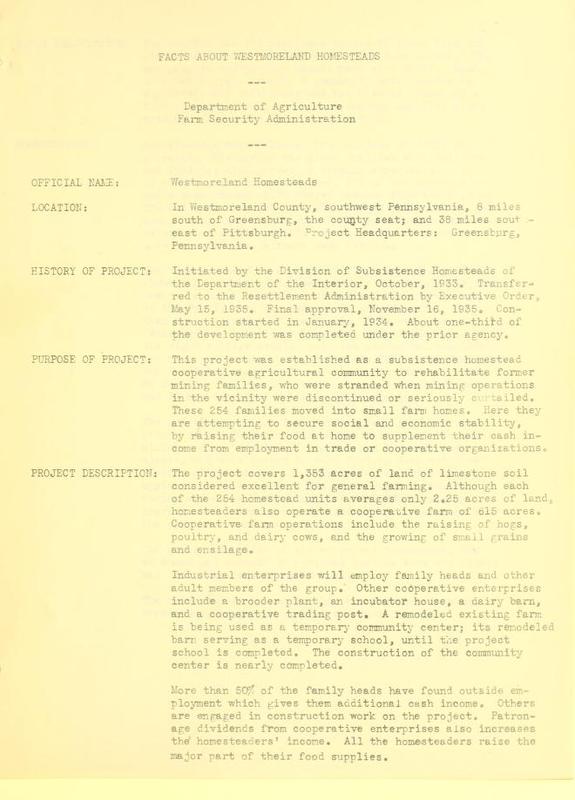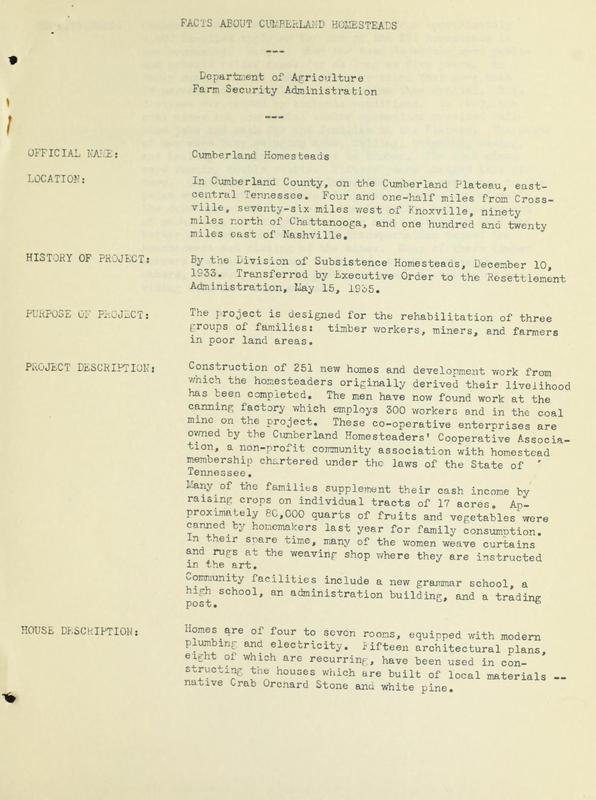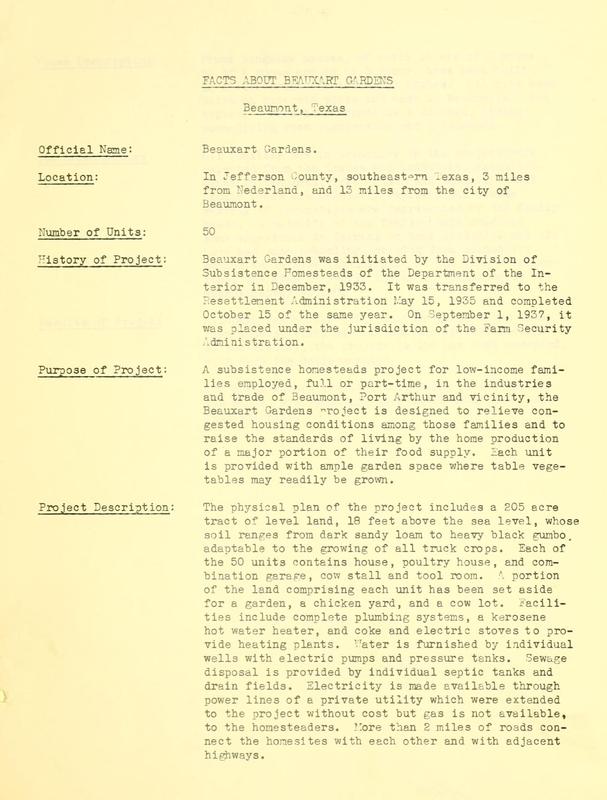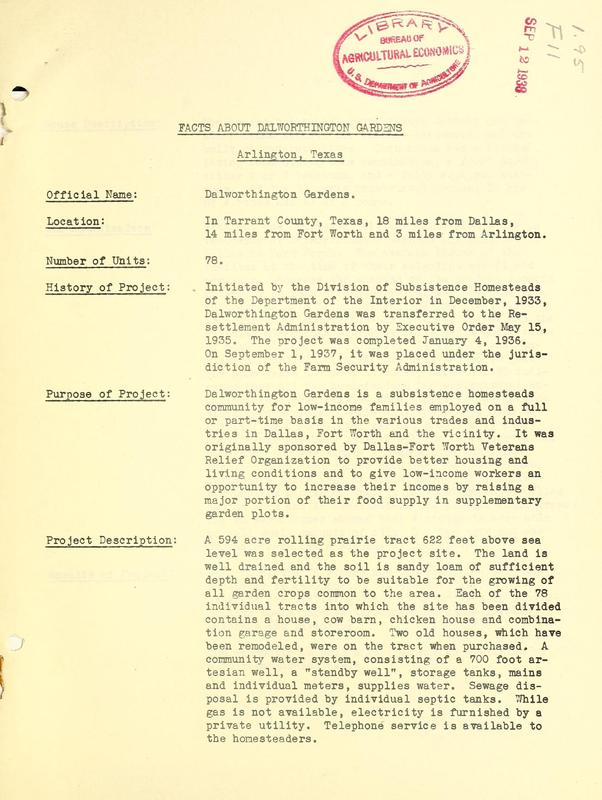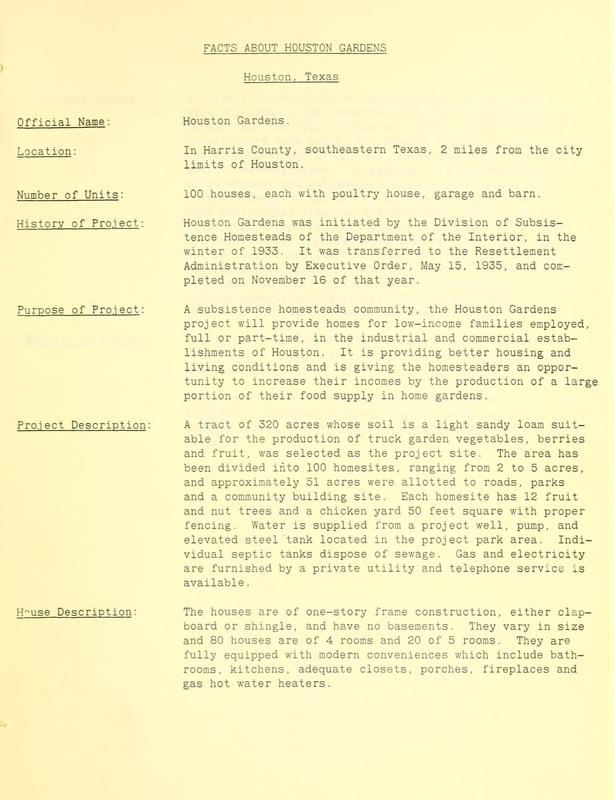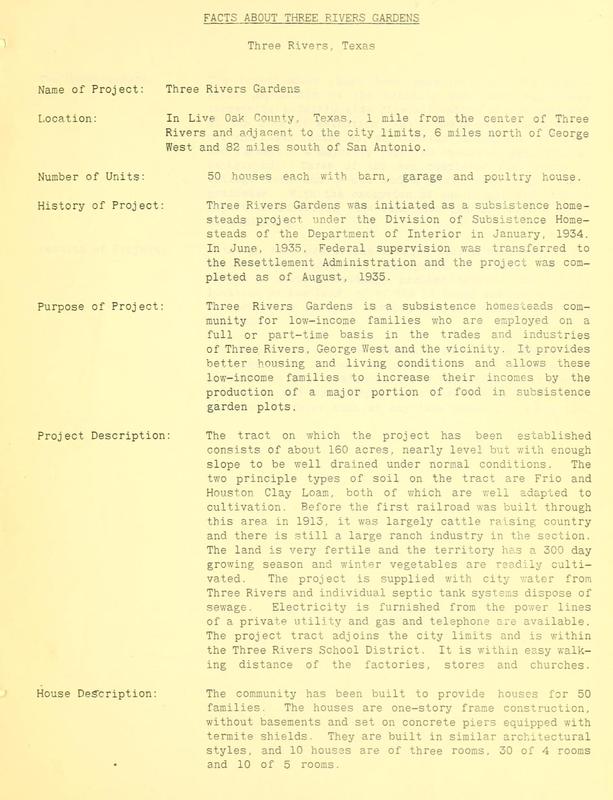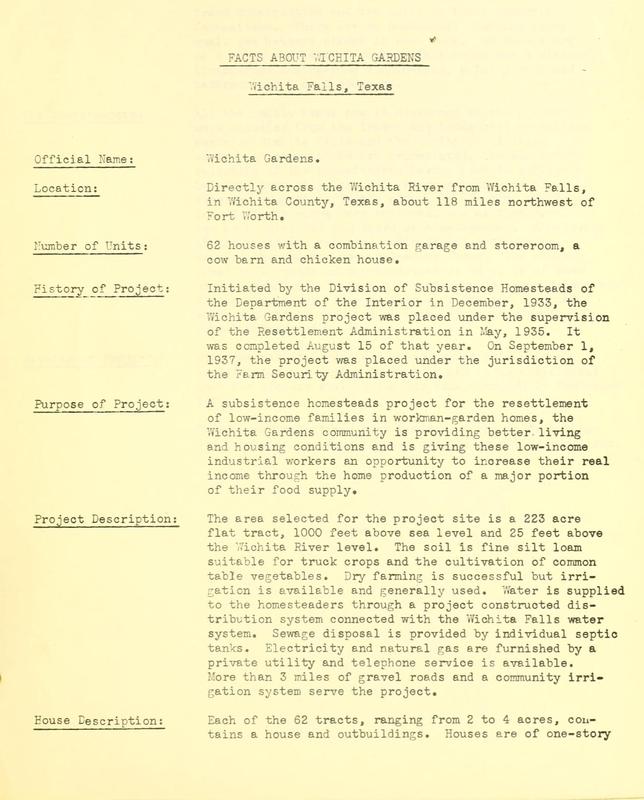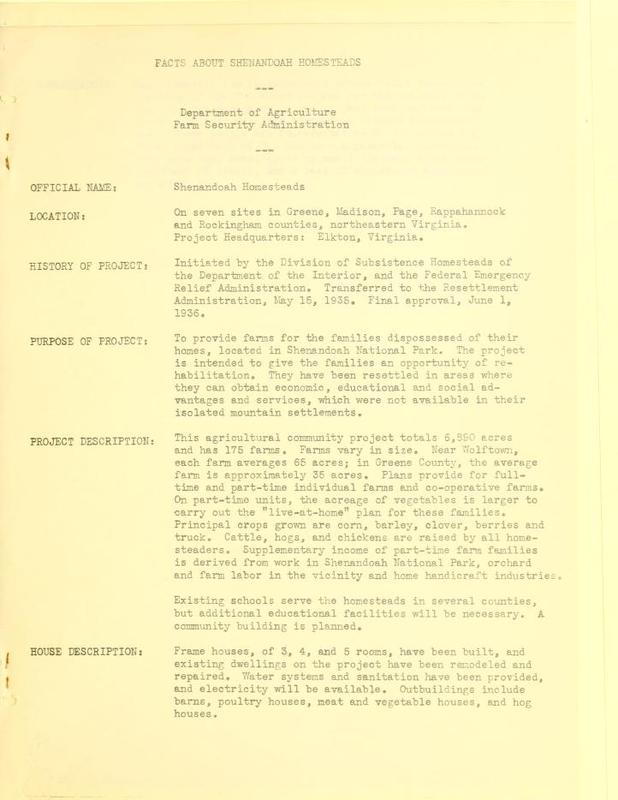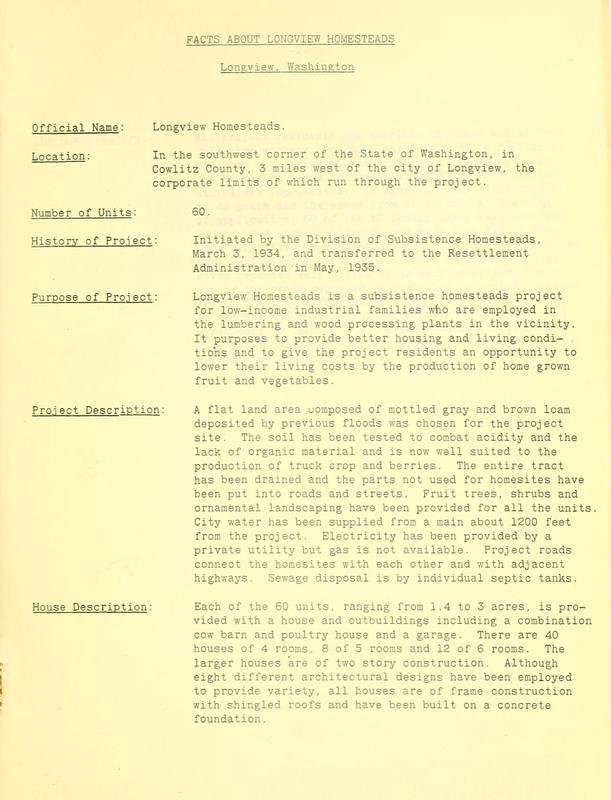Project Summaries
One of the new houses at Slagheap Village, Alabama, (1937). Rothstein, Arthur, 1915-1985, Photographer. Library of Congress, Prints and Photographs Division. LC-USF34-005933-D.
Ultimately, there were 34 projects approved and built by the Division of Subsistence Homesteads. The National Agricultural Library holds project summaries for all but two of these sites. Here are the original U.S. Department of Agriculture documents:
Bankhead Farms Project [Jasper, Alabama]
Farm Security Administration
"In northwest quarter of Alabama, in Walker County, 5 miles north of the City of Jasper and 45 miles northwest of Birmingham.
100 houses and barns which contain garage space, cow stall, chicken house and small granary.
Initiated by the Division of Subsistence Homesteads of the Department of the Interior in the latter part of 1933, the project was transferred to the Resettlement Administration May 15, 1935. The first unit was completed April 30, 1936, and the second during the following winter.
The Bankhead Farms Project was initiated as a garden-homes project to relieve the uneconomical and unhealthful concentration of industrial population in the vicinity of Jasper. By means of subsistence gardens, occupant families are being given an opportunity to enjoy the benefits to be derived from a healthy environment, and to supplement their earnings from industry, commerce, or mining by the raising of a small cash crop and by the production of food for home consumption.
A tract of about 2000 acres of land whose soil is suitable for the production of common garden vegetables was selected as the project site. The topography of the land is nearly level, gently undulating. Those portions subject to soil erosion are terraced and wooded portions are being carefully conserved. Individual wells, automatic electric pumps and storage tanks supply water. Sewage disposal is furnished by individual septic tanks. While gas is not available, electricity is provided by power lines of a private utility company. Transportation facilities are ample and residents have easy access to nearby cities by railroad and bus lines.
Each of the 100 tracts, ranging from 9 to 25 acres, contains a frame house, complete with kitchen, living room, bedrooms, and front and back service porches. The houses are heated by fire-places. 42 houses have four rooms; 49 have five rooms; and 9 have six rooms. Variety in construction has been provided by building the houses in six architectural designs."
Facts About Greenwood Homesteads [Birmingham, Alabama]
Farm Security Administration
"Initiated by the Division of Subsistence Homesteads, of the Department of the Interior, Greenwood Homesteads was transferred to the Resettlement Administration by Executive Order, May 15, 1935. Construction was started in January, 1936.
This subsistence homestead community project was undertaken to help low-income families, dependent upon part-time or full-time employment in the industrial areas surrounding Birmingham, to increase their real income by raising food needs at home. Better housing and an opportunity to improve their living standards is being given 83 selected families."
Facts About Mount Olive Homesteads [Birmingham, Alabama]
Farm Security Administration
"DESCRIPTION OF THE PROJECT: Initiated by the Division of Subsistence Homesteads of the Department of Interior. Transferred to the Resettlement Administration by Executive Order, May 15, 1935. Construction started in January, 1936.
PURPOSE OF PROJECT: To provide subsistence homesteads for low-income families dependent upon part-time or full-time employment in the industries and trades of Birmingham and vicinity. The project will give the families an opportunity to supplement their real income by raising most of their food supplies."
Facts About Palmerdale Homesteads [Birmingham, Alabama]
Farm Security Administration
"Initiated by the Division of Subsistence Homesteads of the Interior, the project was transferred to the Resettlement Administration, May 15, 1935. Unit A, consisting of 60 homesteads, was completed December 3, 1935, and Unit B, consisting of 42 additional homesteads, was completed during the early months of 1937, making a total of 102 homesteads in the community.
Purpose of Project: The Palmerdale Homesteads project was designed to raise the standard of living of such low-income industrial and clerical workers of the Birmingham district as were selected for occupancy, through home production of a considerable portion of their food requirements."
Facts About Phoenix Homesteads [Phoenix, Arizona]
Farm Security Administration
"Initiated by the Division of Subsistence Homesteads of the Department of the Interior, the Phoenix Homesteads project was completed by the Resettlement Administration on September 7, 1935.
In the development of this project, a number of objectives were considered. A primary purpose was to provide housing facilities for low-income families employed on full or part-time basis in the agricultural processing plants in the vicinity of the project, on large scale truck and fruit gardens and in the mines, shops and other industrial enterprises in and near Phoenix. Consideration was also given to providing supplementary income to health-seekers and war veterans retired on small pensions. In general, it was sought to provide healthful living conditions and an opportunity to increase the real income of the workers by home production of a large part of their foodstuffs. The incomes of the residents ranged between $600 and $1200, with the average income about $1000 a year."
Facts About El Monte Homesteads [El Monte, California]
Farm Security Administration
"Started as a Federal Subsistence Homesteads project in March, 1934, the El Monte Homesteads was transferred to the Resettlement Administration in June, 1935. Construction work was completed October 15, 1935.
The project was designed to enable low-income families to supplement their earnings by raising much of their own food on garden plots of about three-fourths of an acre which surrounded each home. With a growing season extending through the entire year and soil suitable for raising a variety of crops, it is estimated that the residents can add about $200 a year to their regular incomes."
Facts About San Fernando Homesteads [Reseda, California]
Farm Security Administration
"Initiated by the Subsistence Homesteads Division of the Department of the Interior, March 3, 1934, San Fernando Homesteads was transferred to the Resettlement Administration for completion, in June, 1935. Construction work was finished November 9, 1935.
PURPOSE OF PROJECT: San Fernando is a subsistence homesteads project for low-income families employed full or part time in the industrial and commercial establishments of Los Angeles and vicinity. It gives the residents an opportunity to increase their real income by producing a major portion of their foodstuffs at home."
Facts About Piedmont Homesteads [Jasper County, Georgia]
Farm Security Administration
"The project was originally planned by the Trustees of the University of Georgia and was later transferred to the Division of Subsistence Homesteads of the Department of the Interior. On May 15, 1935, it was placed under the jurisdiction of the Resettlement Administration.
Purpose of Project: The Piedmont Homesteads was planned to establish low-income agricultural families on self-sufficient farms and to demonstrate the practicability of making satisfactory sized farms out of large cotton plantations that were more or less abandoned because of the hazards of producing cotton under the boll weevil conditions. The agricultural trend at the time of project planning was a continuance of the old system with the consequent abandonment of farms with migration to the cities in search of jobs whereby the families might earn enough for mere existence."
Facts About Lake County Homesteads [Chicago, Illinois]
Farm Security Administration
"Lake County Homesteads was initiated by the Subsistence Homesteads Division of the Department of the Interior, March 29, 1934. On July 20, 1935, the project was transferred to the Resettlement Administration, and it is now under the supervision of the Farm Security Administration.
This project was established to enable families employed in industries in Lake County and vicinity to own homes outside the confines of industrial cities. While many of these families formerly lived in reasonably good dwellings in the various cities, they were subjected to cramped space and did not have sufficient capital to purchase homes on terms that commercial real estate firms were able to offer. It is expected that truck crops and poultry will help decrease food costs thus enabling the homesteaders to apply a greater share of their income toward retirement of payments on their new homes. It is possible that some of the homesteaders may be able to produce a surplus for sale thus supplementing cash incomes."
Facts About Decatur Homesteads [Decatur, Indiana]
Farm Security Administration
"Initiated by the Division of Subsistence Homesteads of the Department of the Interior, December 20, 1933, Decatur Homesteads was transferred to the Resettlement Administration, June 1935. The construction was completed May 8, 1935. On November 1, 1936, the project was turned over to the Decatur Homesteads Association, Inc., a private agency, to be administered by it. All homesteaders are members of this association. It is governed by a board of directors, consisting of three homesteaders, one representative of the city of Decatur, one Resettlement Administration representative. Decatur Homesteads was initiated as a workman's garden community for employed persons only. Its purpose is to provide better housing conditions and to raise the standard of living of part-time employees in the commercial and industrial establishment in the City of Decatur. By means of subsistence gardens, the homesteaders are given an opportunity to increase their real income by the production of home grown fruits and vegetables. Decatur is a small agricultural city, dependent on agriculture and industries allied with farming. The trend in the past has been from agriculture to industry and then reverses when industrial employment slackens."
Granger Homesteads [Granger, Iowa]
Farm Security Administration
"Initiated by the Division of Subsistence Homesteads of the Department of the Interior in March 1934, the Granger Homesteads project was transferred to the Resettlement Administration. May 15, 1935. Occupants were admitted in December 1935.
Purpose of Project: The Granger Homesteads was constructed to provide 50 miners' families with modern homes at low cost, complete with large tracts of land and facilities to permit these families to raise and produce much of their food requirement, thus enabling them to raise the standards of living. Granger, located in the heart of the coal mining area in central Iowa, was chosen as the project site to demonstrate the effectiveness of the subsistence homesteads plan as adapted to the need of part-time workers. There are seven mines within 7 miles of the project and nearly all of the occupants are employed in the mining industry. The industry in this area is characterized by seasonal employment and the period of inactivity, from April to September, coincides with the growing season, thus giving project occupants an opportunity to devote much of their time to the production of the subsistence gardens."
Facts About Austin Acres Project [Austin, Minnesota]
Farm Security Administration
"Austin Acres project was initiated by the Subsistence Homesteads Division of the Department of the Interior in December 1933, and transferred to the Resettlement Administration, May 15, 1935. It was completed on December 15 of that year.
Purpose of Project : Initiated to provide workman's garden homes, Austin Acres serves the seasonally and full-time employed workers in the local packing houses and other industries. It provides better housing and attempts to raise the standard of living of low-income workers through subsistence gardening. Each of the 44 tracts comprising the project consists of from one to nine acres of land and provides ample garden and orchard space."
Facts About Duluth Homesteads [Duluth, Minnesota]
Farm Security Administration
"Duluth Homesteads. In St. Louis County, northeast Minnesota, 7 miles west Duluth and 4 miles north of Proctor. Initiated by Subsistence Homesteads Division of the Department of the Interior. Transferred to the Resettlement Administration by Executive Order. Preliminary R. A. approval, December 30, 1935. Final approval, February 13, 1936. Construction started in June, 1936.
To relieve the housing shortage near Duluth by providing homesteads for low- income families. These families, who are subject to part-time employment, will try to increase their real income by raising food crops at home.
This subsistence homestead community project of 1,220 acres has 84 homesites of 5 and 10 acres each. Homesteaders will raise garden crops and berries, for which soil and climatic conditions are favorable, to supplement income for employment in the city of Duluth. Approximately 400 acres will be reserved for future development."
Facts About Hattiesburg Homesteads Project [Hattiesburg, Mississippi]
Farm Security Administration
"Hattiesburg Homesteads were initiated by the Subsistence Homesteads Division of the Department of the Interior, January 13, 1934. On May 15, 1935 the project was transferred to the Resettlement Administration by Executive Order, and it is now under the jurisdiction of the Farm Security Administration.
Purpose of the Project: The project was established to afford 24 families whose wage-earners are employed in the trades and industries of Hattiesburg more adequate housing and an opportunity to raise their standard of living by producing the major portion of food requirements on subsistence homesteads."
Facts About Magnolia Homesteads [Meridian, Mississippi]
Farm Security Administration
"Magnolia Homesteads were initiated by the Subsistence Homesteads Division of the Department of the Interior, December 15, 1933. The project was transferred to the Resettlement Administration by Executive Order on May 15, 1935, and is at the present under the supervision of the Farm Security Administration.
The purpose of the project is to provide better housing and a higher standard of living for families employed, full-and part-time, in the trades and industries of Meridian. Homesteaders will be able to increase their real income through the production of the greater part of their food needs on small farm tracts."
Facts About McComb Homesteads Project [McComb, Mississippi]
Farm Security Administration
"McComb Homesteads were initiated by the Subsistence Homesteads Division of the Department of the Interior, December 15, 1933. By Executive Order the project was transferred to the Resettlement Administration on May 15, 1935 and it is now under the supervision of the Farm Security Administration.
Low-income families of McComb have been resettled where they will have an opportunity to increase their real income by producing a large portion of their food requirements on subsistence homesteads. Employment of those families is in the railroad shops, textile mills, wood-working shops and other small industries that operate on a seasonal and part-time basis.
264 acres of hill land comprise the project tract. The soil is sandy loam, underlaid with clay, and is suitable to the growth of all of the crops common in the area. Individual homesites average 8 acres, on which each family will raise vegetables, fruit, poultry, and livestock. Each tract contains some wooded land and a truck garden, and all have combination garage and well house and a combination cow stall, chicken house, and store room. Land surrounding a 12-acre lake is to be developed into a park and recreation area. Project roads have been completed. Children of school age are transported to McComb by county school bus.
Eighteen houses are frame clapboard construction and two are frame shingle. All have modern plumbing and are wired for electricity, although connection with a source of current has not been made yet. Individual wells and gasoline pumps provide water and septic tanks and tile drains dispose of sewage. Fireplaces will furnish heat. One house has three rooms, 8 have four rooms, 10 have five rooms, and 1 has six rooms."
Facts About Richton Homesteads [Richton, Mississippi]
Farm Security Administration
"Richton Homesteads were started by the Subsistence Homesteads Division of the Department of the Interior on December 15, 1933, and was transferred to the Resettlement Administration by Executive Order, May 15, 1935. The project is now under the jurisdiction of the Farm Security Administration.
Purpose of Project: The project was initiated to resettle 26 carefully chosen families from among those stranded by the curtailment of lumber operations in the area and other low-income groups. Opportunities for achieving improved living standards and better housing will be afforded on the project. The project is advantageously located to markets for farm products and there are part-time and seasonal work opportunities in the area."
Facts About Tupelo Homesteads [Tupelo, Mississippi]
Farm Security Administration
"Initiated by Subsistence Homesteads division of the Department of the Interior. Approved December 15, 1933. Construction of original 25 units (Unit A) started August 7, 1934 and completed October 25, 1934. Transferred to Resettlement Administration by Executive Order, May 15, 1935. Construction of 10 additional units (Unit B) began April 10, 1936; completed, August 12, 1936.
The project was designed to give 35 low-income families better housing, and an opportunity of increasing their real income by raising subsistence crops. Homesteaders work in nearby Tupelo and practice a "live-at -home" plan on the project.
PROJECT DESCRIPTION: Individual home-sites on this 170 acre project average 3.12 acres. The remaining acreage is allotted to parks and roads. One of the two parks on the project has a 6-acre lake. Near the lake, a spring house and dancing pavilion have been constructed, and also several miles of gravel roads. Homesteaders will raise truck crops, mostly vegetables, and will keep poultry and livestock."
Facts About Jersey Homesteads [Highstown, New Jersey]
Farm Security Administration
"The project is located five miles from Hightstown in Monmouth County, New Jersey. It is approximately 45 miles from both New York City and Philadelphia.
Initiated by the Division of Subsistence Homesteads, December 2, 1933 Jersey Homesteads was transferred to the Resettlement Administration on June 16, 1936, and is now under the supervision of the Farm Security Administration.
The original objectives of this industrial-agricultural community were to demonstrate the feasibility of decentralizing an industry which for years has been concentrated in congested areas of large cities amidst slum living conditions and sweat shop working conditions to demonstrate the merits of combining farming with work in a predominantly seasonal industry and one which is subject to the dictates of fashion; to conduct an experiment in cooperative working and living.
Jersey Homesteads includes a gently rolling tract of 1,200 acres, 500 of which are used for farm land and the remainder for 200 homes on one-half acre sites; a community school, factory building, poultry yard, modern water and sewage plants, and sites reserved for future shops and stores."
Facts About Penderlea Farms Project [Pender County, North Carolina]
Farm Security Administration
"The project is intended to relocate low-income and destitute tenant farms on small farms, and to give them a chance to supplement their farm income by wages earned in a hosiery mill established in the community.
PROJECT DESCRIPTION
One hundred and ninety-five farm units have been completed, of which 164 are now occupied. The average farm at Penderlea consists of 28 acres. Farms are grouped around a community center. Every farm has a dwelling, a chicken house with fenced-in run, a barn, poultry house, smokehouse, sanitary privy, and a movable hog house and pump house. All dwellings are white with green roof and blinds. The homes are one-story four, five, and six-room dwellings of frame-dropsiding construction. They are mounted on brick tiers with roofs of creosoted cedar shingles, ceilings of celotex, walls of six to eight-inch tongue and grooved pine board, and floors of scraped and oiled pine. Most of the houses have bathroom, built-in cabinets in the kitchen, a sewerage system consisting of septic tank and drain field, a water system consisting of pump house, well, electric pump, and pressure tank, a hot water tank, fireplace, and screened-in work porch.
Flowers, shrubbery, and close-clipped lawns make the simple homes attractive. Each home is located on a road leading to the community center.
One of the finest rural schools in North Carolina stands at the south end of the horseshoe-shaped center. It is flanked on the east by the auditorium, the teacherage, administration building, educational shops, and the vegetable packing shed. On the west is the gymnasium, economics and social building, cooperative store, and potato storage house."
Facts About Westmoreland Homesteads [Greensburg, Pennsylvania]
Farm Security Administration
"This project was established as a subsistence homestead cooperative agricultural community to rehabilitate former mining families, who were stranded when mining operations in the vicinity were discontinued or seriously curtailed. These 254 families moved into small farm homes. Here they are attempting to secure social and economic stability, by raising their food at home to supplement their cash income from employment in trade or cooperative organizations.
PROJECT DESCRIPTION: The project covers 1,353 acres of land of limestone soil considered excellent for general farming. Although each of the 254 homestead units averages only 2.25 acres of land homesteaders also operate a cooperative farm of 615 acres. Cooperative farm operations include the raising of hogs, poultry, and dairy cows, and the growing of small grains and ensilage.
Industrial enterprises will employ family heads and other adult members of the group. Other cooperative enterprises include a brooder plant, an incubator house, a dairy barn, and a cooperative trading post. A remodeled existing farm is being used as a temporary community center; its remodeled barn serving as a temporary school, until the project school is completed. The construction of the community center is nearly completed.
More than 50% of the family heads have found outside employment which gives them additional cash income. Others are engaged in construction work on the project. Patronage dividends from cooperative enterprises also increases the homesteaders' income. All the homesteaders raise the major part of their food supplies."
Facts About Cumberland Homesteads [Crossville, Tennessee]
Farm Security Administration
"In Cumberland County, on the Cumberland Plateau, east-central Tennessee. Four and one-half miles from Crossville, seventy-six miles west of Knoxville, ninety miles north of Chattanooga, and one hundred and twenty miles east of Nashville.
By the Division of Subsistence Homesteads, December 10, 1333. Transferred by Executive Order to the Resettlement Administration, May 15, 1935.
The project is designed for the rehabilitation of three groups of families: timber workers, miners, and farmers in poor land areas.
Construction of 251 new homes and development work from which the homesteaders originally derived their livelihood has been completed. The men have now found work at the canning factory which employs 300 workers and in the coal mine on the project. These co-operative enterprises are owned by the Cumberland Homesteaders' Cooperative Association, a non-profit community association with homestead membership chartered under the laws of the State of Tennessee.
Many of the families supplement their cash income by raising crops on individual tracts of 17 acres. Approximately 80,000 quarts of fruits and vegetables were canned by homemakers last year for family consumption. In their spare time, many of the women weave curtains and rugs at the weaving shop where they are instructed in the art."
Facts About Beauxart Gardens Homesteads [Beaumont, Texas]
Farm Security Administration
"Beauxart Gardens was initiated by the Division of Subsistence Homesteads of the Department of the Interior in December, 1933. It was transferred to the resettlement Administration May 15, 1935 and completed October 15 of the same year. On September 1, 1937, it was placed under the jurisdiction of the Farm Security Administration.
Purpose of Project: A subsistence homesteads project for low-income families employed, full or part-time, in the industries and trade of Beaumont, Port Arthur and vicinity, the Beauxart Gardens project is designed to relieve congested housing conditions among those families and to raise the standards of living by the home production of a major portion of their food supply. Each unit is provided with ample garden space where table vegetables may readily be grown."
Facts About Dalworthington Gardens [Arlington, Texas]
Farm Security Administration
"Initiated by the Division of Subsistence Homesteads of the Department of the Interior in December, 1933, Dalworthington Gardens was transferred to the Resettlement Administration by Executive Order May 15, 1935. The project was completed January 4, 1936. On September 1, 1937, it was placed under the jurisdiction of the Farm Security Administration.
Purpose of Project: Dalworthington Gardens is a subsistence homesteads community for low-income families employed on a full or part-time basis in the various trades and industries in Dallas, Fort Worth and the vicinity. It was originally sponsored by Dallas-Fort Worth Veterans Relief Organization to provide better housing and living conditions and to give low-income workers an opportunity to increase their incomes by raising a major portion of their food supply in supplementary garden plots.
A 594 acre rolling prairie tract 622 feet above sea level was selected as the project site. The land is well drained and the soil is sandy loam of sufficient depth and fertility to be suitable for the growing of all garden crops common to the area. Each of the 78 individual tracts into which the site has been divided contains a house, cow barn, chicken house and combination garage and storeroom. Two old houses, which have been remodeled, were on the tract when purchased. A community water system, consisting of a 700 foot artesian well, a "standby well", storage tanks, mains and individual meters, supplies water. Sewage disposal is provided by individual septic tanks. While gas is not available, electricity is furnished by a private utility. Telephone service is available to the homesteaders."
Facts About Houston Gardens [Houston, Texas]
Farm Security Administration
"Houston Gardens was initiated by the Division of Subsistence Homesteads of the Department of the Interior, in the winter of 1933. It was transferred to the Resettlement Administration by Executive Order, May 15, 1935, and completed on November 16 of that year.
A subsistence homesteads community, the Houston Gardens project will provide homes for low-income families employed, full or part-time, in the industrial and commercial establishments of Houston. It is providing better housing and living conditions and is giving the homesteaders an opportunity to increase their incomes by the production of a large portion of their food supply in home gardens.
A tract of 320 acres whose soil is a light sandy loam suitable for the production of truck garden vegetables, berries and fruit, was selected as the project site. The area has been divided into 100 homesites, ranging from 2 to 5 acres, and approximately 51 acres were allotted to roads, parks and a community building site. Each homesite has 12 fruit and nut trees and a chicken yard 50 feet square with proper fencing. Water is supplied from a project well, pump, and elevated steel tank located in the project park area. Individual septic tanks dispose of sewage. Gas and electricity are furnished by a private utility and telephone service is available."
Facts About Three Rivers Gardens [Three Rivers, Texas]
Farm Security Administration
"Three Rivers Gardens was initiated as a subsistence homesteads project under the Division of Subsistence Homesteads of the Department of Interior in January, 1934. In June, 1935, Federal supervision was transferred to the Resettlement Administration and the project was completed as of August, 1935.
Three Rivers Gardens is a subsistence homesteads community for low-income families who are employed on a full or part-time basis in the trades and industries of Three Rivers, George West and the vicinity. It provides better housing and living conditions and allows these low-income families to increase their incomes by the production of a major portion of food in subsistence garden plots."
Facts About Wichita Gardens [Wichita Falls, Texas]
Farm Security Administration
"Initiated by the Division of Subsistence Homesteads of the Department of the Interior in December, 1933, the Wichita Gardens project was placed under the supervision of the Resettlement Administration in May, 1935. It was completed August 15 of that year. On September 1, 1937, the project was placed under the jurisdiction of the Farm Security Administration.
A subsistence homesteads project for the resettlement of low-income families in workman-garden homes, the Wichita Gardens community is providing better living and housing conditions and is giving these low-income industrial workers an opportunity to increase their real income through the home production of a major portion of their food supply."
Facts About Aberdeen Gardens Homesteads [Newport News, Virginia]
Farm Security Administration
"Aberdeen Gardens, near Newport News, Virginia, was built by the Farm Seourity Administration to provide hones and gardens for 158 low-income Negro families.
Housing for low-income workers in Newport News does not meet adequate standards. The majority of the working families live in old frame homes that are often lighted with coal oil lamps, have no running water, central heating, or bathrooms. This is particularly true of the Negro homes. Aberdeen Gardens was designed to give these colored families a chance to buy or rent good homes. Furthermore, in order that the workers could profitably use the seasonal summer slack in employment, and to show the value of a large carefully cultivated garden, each house was placed on a half-acre tract.
The 444 acre project lies approximately 4 miles from the shopping center of Newport News. There are 52 three room houses, 80 of four rooms, and 26 five room houses. All are two stories high and simply designed. They have brick veneer walls, concrete foundations, wood shingle roofs, are thoroughly insulated, and have garage-laundries attached."
Facts About Shenandoah Homesteads [Five Counties in Virginia]
Farm Security Administration
"Initiated by the Division of Subsistence Homesteads of the Department of the Interior, and the Federal Emergency Relief Administration. Transferred to the Resettlement Administration, May 15, 1935. Final approval, June 1, 1936.
PURPOSE OF PROJECT: provide farms for the families dispossessed of their homes, located in Shenandoah National Park. The project is intended to give the families an opportunity of rehabilitation. They have been resettled in areas where they can obtain economic, educational and social advantages and services, which were not available in their isolated mountain settlements.
PROJECT DESCRIPTION: This agricultural community project totals 6,390 acres and has 175 farms. Farms vary in size. Near Wolftown, each farm averages 65 acres; in Greene County, the average farm is approximately 35 acres. Plans provide for full-time and part-time individual farms and co-operative farms. On part-time units, the acreage of vegetables is larger to carry out the "live-at-home" plan for these families. Principal crops grown are corn, barley, clover, berries and truck [sic]. Cattle, hogs, and chickens are raised by all homesteaders. Supplementary income of part-time farm families is derived from work in Shenandoah National Park, orchard and farm labor in the vicinity and home handicraft industries."
Facts About Longview Homesteads [Longview, Washington]
Farm Security Administration
"Initiated by the Division of Subsistence Homesteads, March 3, 1934, and transferred to the Resettlement Administration in May, 1935.
Longview Homesteads is a subsistence homesteads project for low-income industrial families who are employed in the lumbering and wood processing plants in the vicinity. It purposes to provide better housing and living conditions and to give the project residents an opportunity to lower their living costs by the production of home grown fruit and vegetables.
A flat land area composed of mottled gray and brown loam deposited by previous floods was chosen for the project site. The soil has been tested to combat acidity and the lack of organic material and is now well suited to the production of truck crop and berries. The entire tract has been drained and the parts not used for homesites have been put into roads and streets. Fruit trees, shrubs and ornamental landscaping have been provided for all the units. City water has been supplied from a main about 1200 feet from the project. Electricity has been provided by a private utility but gas is not available. Project roads connect the homesites with each other and with adjacent highways. Sewage disposal is by individual septic tanks.
Each of the 60 units, ranging from 1.4 to 3 acres, is provided with a house and outbuildings including a combination cow barn and poultry house and a garage. There are 40 houses of 4 rooms, 8 of 5 rooms and 12 of 6 rooms. The larger houses are of two story construction. Although eight different architectural designs have been employed to provide variety, all houses are of frame construction with shingled roofs and have been built on a concrete foundation."
Facts About Arthurdale Homesteads [Reedsville, West Virginia]
Farm Security Administration
"One of the first projects of the Division of Subsistence Homesteads of the Department of the Interior, Arthurdale was initiated on October 1, 1933. The project was transferred by Executive Order to the Resettlement Administration May 15, 1935. It is now under the supervision of the Farm Security Administration, successor to the Resettlement Administration.
Purpose: Arthurdale was planned to give a group of families, left without work when the nearby coal mines closed down, a chance to obtain an adequate income and a greater degree of security.
Description: More than 1,100 acres of rolling land, once part of the plantation of Colonel George Fairfax, aide to George Washington, form the project site. In the heart of this area is located the community center, including a general store, a barber shop, post office, meeting hall, display room, handicraft work shop, administrative offices, and filling station. On the side of a hill, overlooking the community center and a large portion of the project, is an inn. The school and the community health center are nearby.
Around this group of community buildings, the 165 homesteads are laid out. Each of these units consist of about three acres of land on which has been placed an adequate home, a combination barn and poultry house, and a vegetable storage cellar. They are placed so as to utilize the best house sites, and face on the project roads."
Facts About Tygart Valley Homesteads [Elkins, West Virginia]
Farm Security Administration
"Project is located geographically in the center of West Virginia, in Randolph County, ten miles southwest of Elins, the county seat.
Initiation: By the Division of Subsistence Homesteads, December 21, 1933, and transferred to the Resettlement Administration June 16, 1935.
Purpose: The purpose of the project is to demonstrate the possibilities of rehabilitating the families of stranded miners and lumber workers. (Randolph County was once the center of a very active lumber trade, but in recent years most of its timber land has been cut over and all but two of its large sawmills have been closed. Most of these lumber men are now stranded in the abandoned lumbering towns, their former livelihood gone. In addition, more than two-thirds of those who were formerly employed in the mines are now stranded in the abandoned mining camps. While Randolph County has never been the center of the coal producing area of West Virginia, the industry has been important in the county. At the present time, there are only two important mines left, one era employing 260 men and the other 140.
The Tygart Valley project was initiated for the purpose of rehabilitating these destitute mining and timber workers, both socially and economically, by establishing them in their own homes and providing new forms of livelihood. In the beginning, the occupants will derive their livelihood from the construction and development work on the project and thereafter their income will be derived from the operation of community enterprises now being initiated, supplemented by cash end real incomes produced on their individual tracts."
 An official website of the United States government.
An official website of the United States government.



